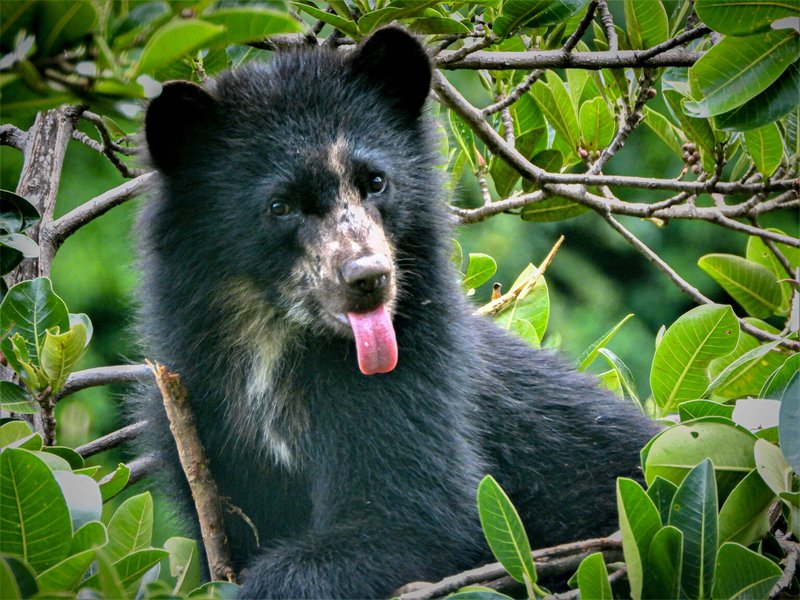
Spectacled bears, also known as Andean bears, are the only bear species native to South America and are often found in the Andes mountains. Their gentle demeanor and herbivorous diet make them fascinating but also unpredictable creatures to encounter. If you ever find yourself face-to-face with one, knowing how to react can mean the difference between a memorable moment and a dangerous situation. Let’s dive into what you should do if you ever come across a spectacled bear in the wild.
Recognizing a Spectacled Bear
Before you find yourself in a situation where you encounter a spectacled bear, it’s important to know what they look like. These bears are easily distinguished by the unique markings on their faces. The splashes of white or cream around their eyes resemble spectacles, lending them their name. They have a stocky build, short legs, and are covered in thick fur that can range from black to brown.
You might be wondering where to find them. Spectacled bears typically inhabit cloud forests, grassy alpine areas, and even scrublands. They are mostly solitary creatures and are known for their climbing abilities—often seen perched high in trees munching on fruits. Being aware of their habitat and behavior can help reduce the chances of an unexpected encounter.
Staying Calm in a Close Encounter
If you’re lucky—or unlucky—enough to find yourself near a spectacled bear, the first rule is to stay calm. It’s easy to panic, but remember that the bear is likely just as startled as you are. Take a moment to breathe and assess the situation. Avoid sudden movements or loud noises; these can startle the bear and make it feel threatened.
Being still can work in your favor. Often, a bear will just wander away if it feels no immediate danger. If the bear is simply passing through, your best bet is to let it do just that. Stand still, keep your hands at your sides, and avoid making direct eye contact, which can be seen as a challenge.
Making Your Presence Known
Once you’ve composed yourself, you’ll want to let the bear know you’re there—without startling it. Use your voice in a calm, firm tone. Saying something simple like, “Hey, bear!” can signal your presence. This is often enough to alert the bear without causing it to feel threatened.
If the bear starts to approach you, it’s essential to stand your ground. Backing away slowly while talking can help. Don’t run! Bears can run much faster than humans, and running might trigger a chase instinct.
Understanding Bear Behavior
To navigate a close encounter, understanding bear behavior is vital. Spectacled bears are not typically aggressive unless they feel cornered or threatened. They are mostly herbivorous, feeding on fruits, leaves, and other vegetation, which means they’re not usually interested in humans as a food source.
However, a mother bear with cubs is a different story. If you spot cubs, that’s a clear cue to maintain your distance, as mothers are very protective. If you inadvertently get too close to a mother and her cubs, it can lead to an aggressive reaction in defense of her young. Knowing this can help you gauge the bear’s intent.
What to Do If a Bear Approaches
If the bear approaches you despite your efforts, it’s crucial to know how to respond. First, stand tall and keep your arms raised to make yourself appear larger, but do it slowly. You might feel your heart racing, and that’s totally normal. Take a deep breath.
Next, you can try to *scare it off* by making loud noises. Clapping your hands, shouting, or using any nearby objects to create noise can help. The idea is to reinforce that you’re not a threat, and you want the bear to move away. If the bear continues to come closer or acts strangely, like swaying its head or making huffing sounds, it may be preparing to assert dominance, and that’s your cue to back away slowly.
Contacting Wildlife Authorities
After your encounter, whether it was calm or stressful, it’s a good idea to report it to wildlife authorities. Sharing your experience can help them monitor bear activity and alert other hikers or visitors in the area. Furthermore, if the bear has displayed aggressive behavior, authorities may need to assess its actions and ensure the safety of both the animal and the public.
You can usually find contact information posted in public areas of hiking trails or national parks. The more information they have, the better equipped they’ll be to handle the bear population and keep everyone safe.
Preparation Before You Go Hiking
Lastly, being prepared can significantly reduce the chances of encountering a bear or knowing how to handle the situation if it does happen. Always do your research before hiking in bear territory. Here are a few tips to keep in mind:
- Travel in groups—bears are less likely to approach larger groups.
- Make noise while hiking, which can alert bears to your presence.
- Carry bear spray, and know how to use it—this is a deterrent if a bear gets too close.
- Store food properly away from your campsite.
Preparation can make all the difference between an unforgettable adventure and a scary moment.
Seeing a spectacled bear in the wild can be a breathtaking experience—if handled correctly. Staying calm, recognizing the signs, and understanding bear behavior can make your encounter safe and memorable. Remember, these bears play an important role in their ecosystem. The more we respect their territory and learn how to coexist, the more we can enjoy the beauty of nature. So, if you ever find yourself face-to-face with a spectacled bear, take a deep breath, trust your instincts, and appreciate the wonder of wildlife surrounding you.

